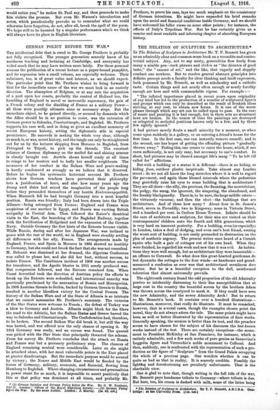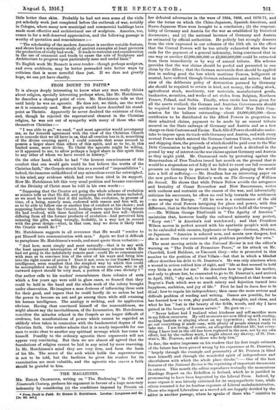THE RELATION OF SCULPTURE TO ARCHITECTURE. , IN The .Relation of
Sculpture to Architecture Mr. T. P. Bennett has given us an admirably clear and common-sense book on a recondite and contro- versial subject. Airy, not to say misty, generalities flow freely from many a nimble pen—such phrases and clichés as "the dictates of good taste," the " canons of art," and the like, that vaguely and sloppily conduct one nowhere. But to resolve general abstract principles into definite precept needs a faculty for clear thinking and lucid expression, both possessed by Mr. Bennett, as well as scholarship and a catholio taste. Certain things said not nearly often enough or nearly forcibly enough are here said with commendable vigour. For example :—
" The inflated importance placed in recent years upon originality of any kind has led to the production of a number of sculptured figures and groups which can only be described as the result of freakish ideas striving, at any coat, to obtain new forms. It is one of the worst phases through which any art can be called upon to pass. In the case of music and painting it is bad enough, but in these arts no structural laws are broken. In the course of time the paintings are destroyed or relegated to secluded positions known only to a few, and by those few rightly ignored."
A bad picture merely flouts a small minority for a moment, as when come upon suddenly in a gallery, or on entering a friend's house for the first time. In the first case, one can instantly remove oneself ; and in the second, one has hopes of getting the offending picture "gradually thrown away." Failing this, one ceases to enter the house, which, if one cares sufficiently, is not only easy, but necessary to one's comfort. In short, bad pictures may be classed amongst life's many " To be left till called for " afflictions.
But with a building or a statue it is different—there is no hiding, or hiding from, outdoor plastic ineptitude. Take almost any London street : do we not all know the long stretches where it is well to regard the pavement, and again those blessed intervals where the pedestrian may gratefully raise his eyes to some building that is architecture They are all there—the silly, the precious, the flaunting, the meretricious the podgy, the smug, the ignorant, the simpering, the abandoned, and the frankly blackguardly. There is, to be sure, the large middle estate— the virtuously vacuous; and then the elect—the buildings that are architecture. And of these how many ? About four in St. James's Street, seven in Piccadilly, two in Kingaway, none in Victoria Street, and a hundred per cent. in Carlton House Terrace. Infinite should be the care of architects and sculptors, for their sins are visited on their contemporaries' children unto the fourth and fifth generations, which is very hard on innocent posterity. For a building, even (or especially) in London, takes a deal of dodging, and even one's best friend, owning the worst sort of building, is not easily persuaded to destruction on the plea of aesthetic urgency. The present writer once heard of a Cornish squire who built a pair of cottages out of his own head. When they were finished, he regarded his work and saw that it was evil. As habita. tions they were well enough, but as architecture they were lamentable—. an offence to Cornwall. So what does this great-hearted gentleman de but dynamite the cottages to the four winds—as handsome and grand- mannered a confession as ever was that architectural seemliness does matter. But he is a beautiful exception to the dull, uninformed toleration that almost universally prevails.
The eighteenth century found the odd proportion of the old Admiralty portico so intolerably distressing to their fine susceptibilities that at large cost to the country the beautiful screen by the brothers Adam was thrown across the courtyard to mask it. If they could have seen the new Admiralty, and the newer Admiralty Arch t But to return to Mr. Bennett's book. It contains over a hundred illustrations— illustrations, moreover, that really do illustrate. It must be remarked, however, that in 8.1veral cases, though the examples chosen point the moral, they do not always adorn the tale. The same points might have been as well or better illustrated by the representation of finer works. Generally speaking, the sermon is better than its text, and the preacher seems to have chosen for the subject of his discourse the beat-known works instead of the best. There are certainly exceptions—the monu- ment to President McKinley at San Francisco, for instance, which is entirely admirable, and a few such works of pure genius as Sansovino's Loggetta figure and Verrocchio's noble monument to Colleoni. And then, suddenly, one is oonfronted with the representation of such a pro- duction as the figure of " Sculpture " from the Grand Palais occupying the whole of a precious page. One wonders whether it can be quite as bad as that in reality, It is scarcely credible. Possibly the lighting and foreshortening are peculiarly unfortunate. That is the oharitable view.
One is glad to note that, though writing in the full tide of the war, Mr. Bennett pays handsome tribute to Germany—where tribute is due. But here, too, his cream is dashed with milk, some of the latter being • The Relation of Sculpture to Archdecture. By T. 1'. Bennett, A.R.I.B.A. Oars. bridge : at the University Brew rise. net.1
little better than skim. Probably he had not seen some of the virile yet scholarly work just completed before the outbreak of war, notably in Cologne, where many new municipal and commercial buildings have made most effective and architectural use of sculpture. America, too, comes in for a well-deserved appreciation, and the following passage is worthy of quotation and remembrance :— " The scholarship of the modem American is another notable feature, and shows how a systematic study of ancient examples at least prevents the production of really bad work. It leads to restraint and consideration in the use of ornament and tends to cause the arts of Sculpture and Architecture to progress upon particularly sane and useful lines."
To English work Mr. Bennett is over-tender---though perhaps sculptors, and even architects, may be better persuaded into better ways by criticism that is more merciful than just. If we dare not greatly hope, we can yet have charity.































 Previous page
Previous page